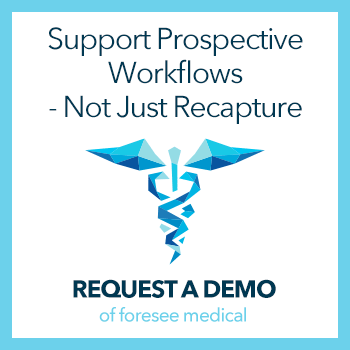Why Prospective Review Will Be the Industry Standard
We are pleased to welcome Dr. Tom Davis as a guest contributor. Dr. Davis is a national expert in value-based healthcare delivery and full-risk insurance contracting. A family physician for over 25 years, he has successfully managed thousands of patients under Medicare Advantage and other value-based care programs. He is a sought-after consultant, speaker, and trusted advisor. You can find more from Dr. Davis at his website.
When a system underperforms, stepping back and re-thinking processes can have a dramatic impact. As the entire Medicare program moves towards a risk assumption model and the financial performance of providers is increasingly put at risk, many organizations are re-engineering their data-integrity programs. The results have been surprising.
For years, the standard approach to ensuring risk-coding accuracy has been the retrospective review. These are not compliance audits, where a a small but statistically significant percentage of encounters are reviewed. These are comprehensive assessments, where every visit note is evaluated to ensure that every risk code supported by the available documentation has been submitted to the payer.
In a retrospective system, the clinician provides their service to the beneficiary, documents appropriately, and sends the information for submission to the payer. Some weeks to months later (and occasionally more than a year later), a coder would review the documentation for the presence of risk-codes which were supported by documentation but not submitted to the payer. The coder is usually physically removed from the point of service and has no background information on the patient or the encounter. Those same coders also find themselves under time pressure to be productive. Once complete, the coder’s assessment is sent back to the provider with recommendations for the submission of additional risk-codes; interrupting the provider’s workflow and forcing them to accurately recall circumstances long in the past.
The result of this process? Diagnostic codes inappropriately submitted, appropriate codes completely missed, and compliance audits triggered, not to mention the frustration and productivity loss of the key driver of value – the clinician. A poor return on a very expensive process.
The origins of this system are easy enough to understand. Twenty years ago, when risk-coding went live, fee-for-service was the dominant payment model and retrospective review of rejected claims was essential for strong performance under that payment model. In that environment, it only made sense for the new risk-coding data-integrity programs to take the same approach.
The challenge is, of course, that fee-for-service and value-based care are completely different payment systems, polar-opposites even. That’s why instead of reviewing data long after the fact, an increasing number of organizations are moving their integrity programs to the point of care. They are evaluating opportunities for coding and care prior to the clinician’s contact with the patient, so all can be effectively addressed at the time of the encounter.
This approach isn’t new. High-performing clinicians have always known that a “pre-review” of a patient’s information prior to an encounter can drive improved outcomes. By making sure the patient’s medical problems are comprehensively identified prior to an encounter, clinicians can increase compliance, level of function, and prevent inpatient stays – all while ensuring payment levels accurately reflect the patient’s disease burden.
The challenge, of course, has been that the manual data mining of these high performers is so labor intensive that only the most skilled and appropriately incentivized clinicians do it. Scaling healthcare analytics requires automation and such automation is tricky. Identification of diagnoses from the medical record is a subtle affair. The clues in the medical record can be hidden in an individual clinician’s unique wording or subtle physical findings. Even the highest performing clinician with a close connection to their patient can easily miss an important condition.
Once this challenge is overcome, however, every patient could undergo a prospective review of possible disease states prior to every encounter, presenting to the clinician at the point of care a list of possible health conditions, which may need to be addressed. The improvement in data-integrity would enormously benefit patients, providers, and payers alike.
Today, the advances of machine learning in healthcare and natural language processing have made automated prospective review a reality, leading to a revolution in data integrity programs. Referencing the data bases of millions of patient encounters, these tools can tease out even the most subtle diagnosis and place that data before the clinician for their immediate assessment at the point of care.
With this information, clinicians can not only address needed interventions, they also can immediately document the care delivered to ensure their documentation supports the diagnostic codes. These prospective systems even facilitate record retrieval for audits and other needs. Given this performance, high-overhead, low-return retrospective audits are quickly becoming a thing of the past.
There is power in data, but data is only a tool and tools are only as effective as the system within which they are utilized. With a fraction of the labor costs of a retrospective system, prospective review is being quickly adopted by high-performing organizations across the industry, improving their data integrity through the power of data properly utilized. Given the increased emphasis on compliance and data accuracy by payer organizations, and the increasing financial risk demanded of providers, look for prospective review to become the industry standard.
And that’s something good for everyone.
For healthcare organizations looking to succeed in the transition to value-based care delivery models, ForeSee Medical is a specialized software platform designed to increase the profitability of Medicare Advantage risk contracts. Using AI including natural language processing, ForeSee Medical perfects HCC risk adjustment scores, empowering providers to positively influence health outcomes.





